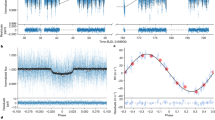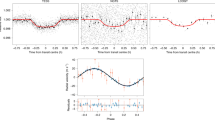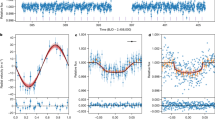Abstract
Over the past two years, the search for low-mass extrasolar planets has led to the detection of seven so-called ‘hot Neptunes’ or ‘super-Earths’ around Sun-like stars. These planets have masses 5–20 times larger than the Earth and are mainly found on close-in orbits with periods of 2–15 days. Here we report a system of three Neptune-mass planets with periods of 8.67, 31.6 and 197 days, orbiting the nearby star HD 69830. This star was already known to show an infrared excess possibly caused by an asteroid belt within 1 au (the Sun–Earth distance). Simulations show that the system is in a dynamically stable configuration. Theoretical calculations favour a mainly rocky composition for both inner planets, while the outer planet probably has a significant gaseous envelope surrounding its rocky/icy core; the outer planet orbits within the habitable zone of this star.
This is a preview of subscription content, access via your institution
Access options
Subscribe to this journal
Receive 51 print issues and online access
$199.00 per year
only $3.90 per issue
Buy this article
- Purchase on Springer Link
- Instant access to full article PDF
Prices may be subject to local taxes which are calculated during checkout



Similar content being viewed by others
References
Mayor, M. & Queloz, D. A Jupiter-mass companion to a solar-type star. Nature 378, 355–359 (1995)
Udry, S., Fischer, D. A. & Queloz, D. in Protostars and Planets V (eds Reipurth, B., Jewitt, D. & Keil, K.) (Univ. Arizona Press, Tucson, in the press)
Schneider, J. The Extrasolar Planets Encyclopaedia. http://exoplanet.eu (10 March 2006).
Perryman, M. A. C. et al. The HIPPARCOS catalogue. Astron. Astrophys. 323, L49–L52 (1997)
Santos, N. C., Israelian, G. & Mayor, M. Spectroscopic [Fe/H] for 98 extra-solar planet-host stars. Exploring the probability of planet formation. Astron. Astrophys. 415, 1153–1166 (2004)
Schaller, G., Schaerer, D., Meynet, G. & Maeder, A. New grids of stellar models from 0.8 to 120 solar masses at Z = 0.020 and Z = 0.001. Astron. Astrophys. Suppl. Ser. 96, 269–331 (1992)
Girardi, L., Bressan, A., Bertelli, G. & Chiosi, C. Evolutionary tracks and isochrones for low- and intermediate-mass stars: From 0.15 to 7 Msun, and from Z = 0.0004 to 0.03. Astron. Astrophys. Suppl. Ser. 141, 371–383 (2000)
Beichman, C. A. et al. An excess due to small grains around the nearby K0 V star HD 69830: Asteroid or cometary debris? Astrophys. J. 626, 1061–1069 (2005)
Mayor, M. et al. Setting new standards with HARPS. Messenger 114, 20–24 (2003)
Pepe, F. et al. The HARPS search for southern extra-solar planets. I. HD 330075 b: A new “hot Jupiter”. Astron. Astrophys. 423, 385–389 (2004)
Santos, N. C. et al. The HARPS survey for southern extra-solar planets. II. A 14 Earth-masses exoplanet around µ Arae. Astron. Astrophys. 426, L19–L23 (2004)
Lovis, C. et al. The HARPS search for southern extra-solar planets. III. Three Saturn-mass planets around HD 93083, HD 101930 and HD 102117. Astron. Astrophys. 437, 1121–1126 (2005)
Udry, S. et al. The HARPS search for southern extra-solar planets. V. A 14 Earth-masses planet orbiting HD 4308. Astron. Astrophys. 447, 361–367 (2006)
Baranne, A. et al. ELODIE: A spectrograph for accurate radial velocity measurements. Astron. Astrophys. 119 (Suppl.), 373–390 (1996)
Bouchy, F., Bazot, M., Santos, N. C., Vauclair, S. & Sosnowska, D. Asteroseismology of the planet-hosting star µ Arae. I. The acoustic spectrum. Astron. Astrophys. 440, 609–614 (2005)
Noyes, R. W., Hartmann, L. W., Baliunas, S. L., Duncan, D. K. & Vaughan, A. H. Rotation, convection, and magnetic activity in lower main-sequence stars. Astrophys. J. 279, 763–777 (1984)
Santos, N. C. et al. The CORALIE survey for southern extra-solar planets. IX. A 1.3-day period brown dwarf disguised as a planet. Astron. Astrophys. 392, 215–229 (2002)
Queloz, D. et al. No planet for HD 166435. Astron. Astrophys. 379, 279–287 (2001)
Correia, A. C. M. et al. The CORALIE survey for southern extra-solar planets. XIII. A pair of planets around HD 202206 or a circumbinary planet? Astron. Astrophys. 440, 751–758 (2005)
Laskar, J. Frequency analysis for multidimensional systems–global dynamics and diffusion. Physica D 67, 257–281 (1993)
Pollack, J. B. et al. Formation of the giant planets by concurrent accretion of solids and gas. Icarus 124, 62–85 (1996)
Alibert, Y., Mordasini, C., Benz, W. & Winisdoerffer, C. Models of giant planet formation with migration and disc evolution. Astron. Astrophys. 434, 343–353 (2005)
Ida, S. & Lin, D. N. C. Toward a deterministic model of planetary formation. I. A desert in the mass and semimajor axis distributions of extrasolar planets. Astrophys. J. 604, 388–413 (2004)
Lecavelier des Etangs, A., Vidal-Madjar, A., McConnell, J. C. & Hébrard, G. Atmospheric escape from hot Jupiters. Astron. Astrophys. 418, L1–L4 (2004)
Baraffe, I., Alibert, Y., Chabrier, G. & Benz, W. Birth and fate of hot-Neptune planets. Astron. Astrophys. (in the press); preprint at http://arXiv.org/astro-ph/0512091 (2005)
Haisch, K. E., Lada, E. A. & Lada, C. J. Disk frequencies and lifetimes in young clusters. Astrophys. J. 553, L153–L156 (2001)
Beckwith, S. V. W. & Sargent, A. I. Circumstellar disks and the search for neighbouring planetary systems. Nature 383, 139–144 (1996)
Tanaka, H., Takeuchi, T. & Ward, W. R. Three-dimensional interaction between a planet and an isothermal gaseous disk. I. Corotation and Lindblad torques and planet migration. Astrophys. J. 565, 1257–1274 (2002)
Alibert, Y., Mousis, O., Mordasini, C. & Benz, W. New Jupiter and Saturn formation models meet observations. Astrophys. J. 626, L57–L60 (2005)
Kasting, J. F., Whitmire, D. P. & Reynolds, R. T. Habitable zones around main sequence stars. Icarus 101, 108–128 (1993)
Acknowledgements
The data presented here were obtained with the ESO 3.6-m telescope at La Silla Paranal Observatory, Chile. We thank O. Tamuz for the development of the genetic algorithm code, and J. Couetdic for his help in studying the stability of the asteroid belt. We thank the Swiss National Science Foundation (FNRS), the Centre National de la Recherche Scientifique (France) and the Fundação para Ciência e a Tecnologia (Portugal) for their continuous support.
Author information
Authors and Affiliations
Corresponding authors
Ethics declarations
Competing interests
Reprints and permissions information is available at npg.nature.com/reprintsandpermissions. The authors declare no competing financial interests.
Supplementary information
Supplementary Table 1
This table contains the 74 radial velocity measurements of the star HD 69830 that we have obtained with the HARPS instrument. The format is ASCII text with a tabulation as separation character. The first column contains the epoch of the measurements as Barycentric Julian Date (BJD) minus 2,400,000 (for clarity). The second column gives the radial velocity of the star in km s-1 relative to the Solar System barycenter. Finally, the third column gives the uncertainties on the measurements in km s-1. (TXT 2 kb)
Rights and permissions
About this article
Cite this article
Lovis, C., Mayor, M., Pepe, F. et al. An extrasolar planetary system with three Neptune-mass planets. Nature 441, 305–309 (2006). https://doi.org/10.1038/nature04828
Received:
Accepted:
Issue Date:
DOI: https://doi.org/10.1038/nature04828
This article is cited by
-
The broadband laser source and an active beam stabilization device for laser calibration systems
Radiation Detection Technology and Methods (2023)
-
Spitzer’s debris disk legacy from main-sequence stars to white dwarfs
Nature Astronomy (2020)
-
A microphotonic astrocomb
Nature Photonics (2019)
Comments
By submitting a comment you agree to abide by our Terms and Community Guidelines. If you find something abusive or that does not comply with our terms or guidelines please flag it as inappropriate.



